Review: A Kaiseki lunch at Gion Suetomo in Kyoto

Kyoto is known for kaiseki, a traditional multi-course Japanese meal made through various techniques such as boiling, grilling and simmering. We were looking for good restaurants and came across the listing of a kaiseki restaurant in Kyoto – Gion Suetomo on Mileslife, an app which I use often to earn miles for airline tickets. I’ve got to say that it was our second Kaiseki experience, (the first being at our ryokan near Lake Kawaguchiko), and it was very good. Here is the review of our Kaiseki lunch at Gion Suetomo in Kyoto. It does live up to its reputation of a 1-Michelin star restaurant.
The Ambience

The experience starts when you enter the restaurant. The landscaping at the entrance is well done. There are Japanese-style plants and there’s the actual sound of water flowing in the background. We sat on a bench made with bamboo sticks. The staff arrived soon after with a welcome drink – it was citrusy and very refreshing.

The Menu – A Kaiseki lunch at Gion Suetomo in Kyoto
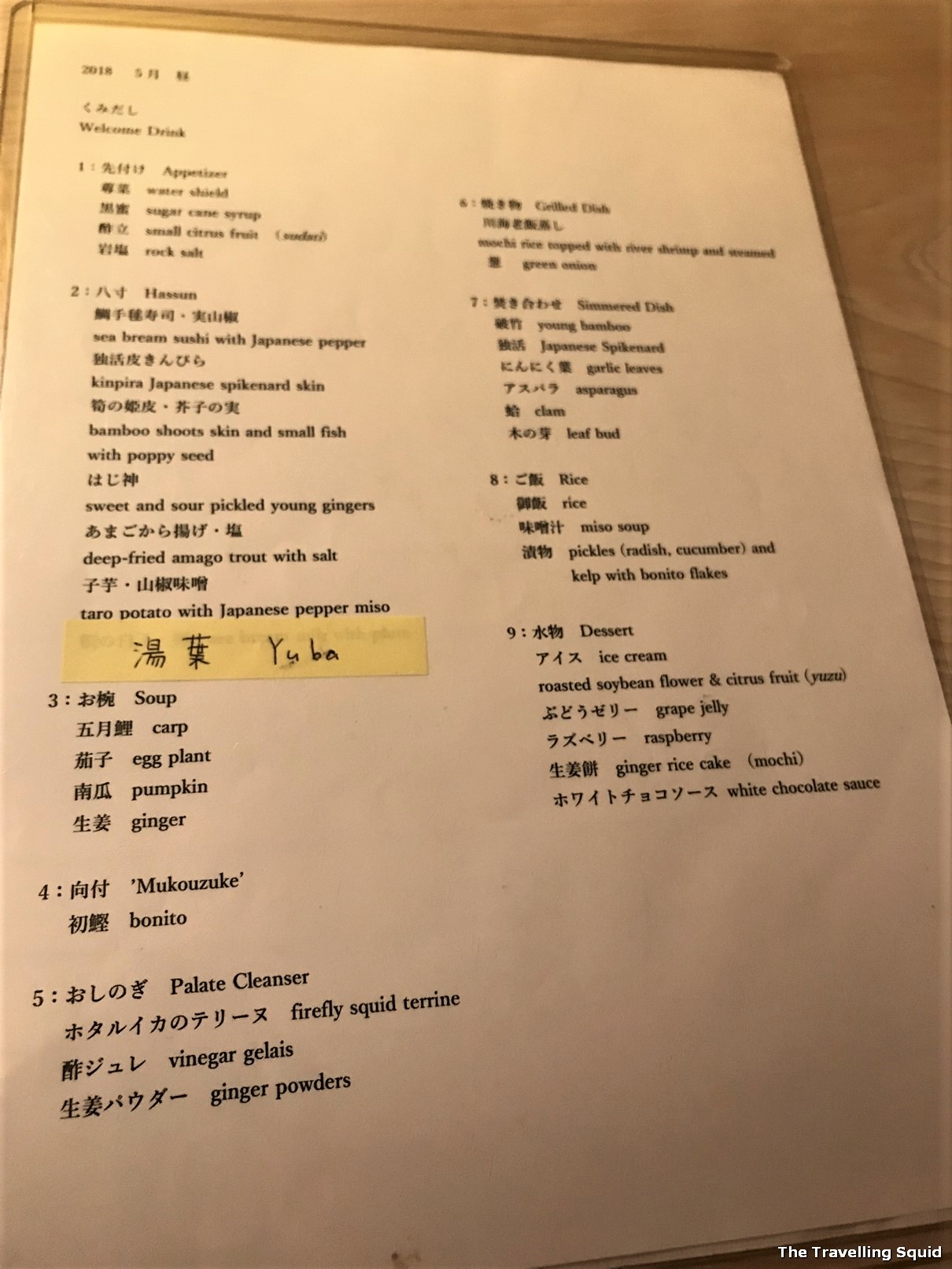
1. Sakizuke (Appetiser)

- Water shield, sugar cane syrup, small citrus fruit (sudachi), rock salt.
This course is similar to the French’s amuse-bouche. It was my first time having water shield, which according to Wikipedia, is a vegetable cultivated in China, and is used in Hangzhou for a local specialty West Lake Water Shield Soup and in Japan (where it is known as junsai). The dish was interesting – it had a good mix of citrus flavours (the sudachi tasted like lime), sweetness from the sugar cane syrup and an element of saltiness from the rock salt.
2. Hassun (the seasonal course)

- Sea bream sushi with Japanese pepper
- Kinpira Japanese spikenard skin
- Bamboo shoots skin and small fish with poppy-seed
- Sweet and sour pickled young gingers
- Deep-fried amago trout with salt
- Tara potato with Japanese pepper miso
- Yuba (tofu skin)
According to the Michelin Guide, the Hassun course is named for the eight-inch wooden platters they are served on. The Hassun course is typically presented as the second course in the kaiseki sequence, and sets the seasonality and tone of the meal.
According to the Michelin Guide, the platter of appetisers may comprise up of four to six items, such as paste-filled broad beans with a flower stem stacked atop to represent the mountains, and a lightly poached Okinawan prawn shaped into a nightingale as a symbol of the sea.
The aesthetics of the plate should draw your eyes from the left side of the platter, which usually has ingredients stacked up to create visible height, to the right side of the platter, to convey the idea of energy flowing from mountain down to the sea. “Looking at the plate should give you a pleasant and calming effect, as though one is looking into a garden,” says (chef Yoshiyuki).
3. Suimono (the Soup course)

- Carp, egg-plant, pumpkin and ginger
Despite its simplicity, the Suimono course is the most important course in a kaiseki sequence and the mark of a chef’s ability. I particularly like this dish because it was light and clean-tasting. The freshness of the carp was brought out by the dash of ginger, making the dish really fragrant. I loved the rice ball which they added to the soup.
According to chef Yoshiyuki from the Michelin Guide, many recipes are derived from trial and error and it may take the chefs many years of experimenting before they perfect their own personal dashi recipe. Even when two people cook the dashi using the same recipe, the taste can differ widely as there are many other aspects that affect the taste, such as timing and precision.”
4. Mukouzuke (a sliced dish of seasonal sashimi)

We had seared bonito for this dish, and it was fresh and delicious. The texture was so flavourful, and it went well with the sliced onion toppings. Delicious.
5. Su-zakana (Palate Cleanser)

- Firefly squid terrine, Vinegar gelais (I think this refers to some sort of jelly), Ginger powders

It made a good dipping sauce for the fried yuba (it was tofu skin if I remembered correctly). The squid terrine was about the same texture as fois gras. That said, it was easily consumed due to the acidity from the vinegar gelais.
6. Yakimono (Grilled dish)

- Mochi rice topped with river shrimp and steamed. With green onions. ᕕ( ՞ ᗜ ՞ )ᕗ
This was my favourite dish. The rice was cooked to perfection – the texture and chewiness was just nice. Although it was glutinous rice, it wasn’t overly sticky and was a perfect combination with the grilled sakura shrimps and spring onions. It was a dish made with simple ingredients, put together with the perfect balance. The plating was done in a casual way – the sakura shrimp appeared to be casually left on the plate, which made it really pleasing to the eye.
7. Takiawase (simmered dish)
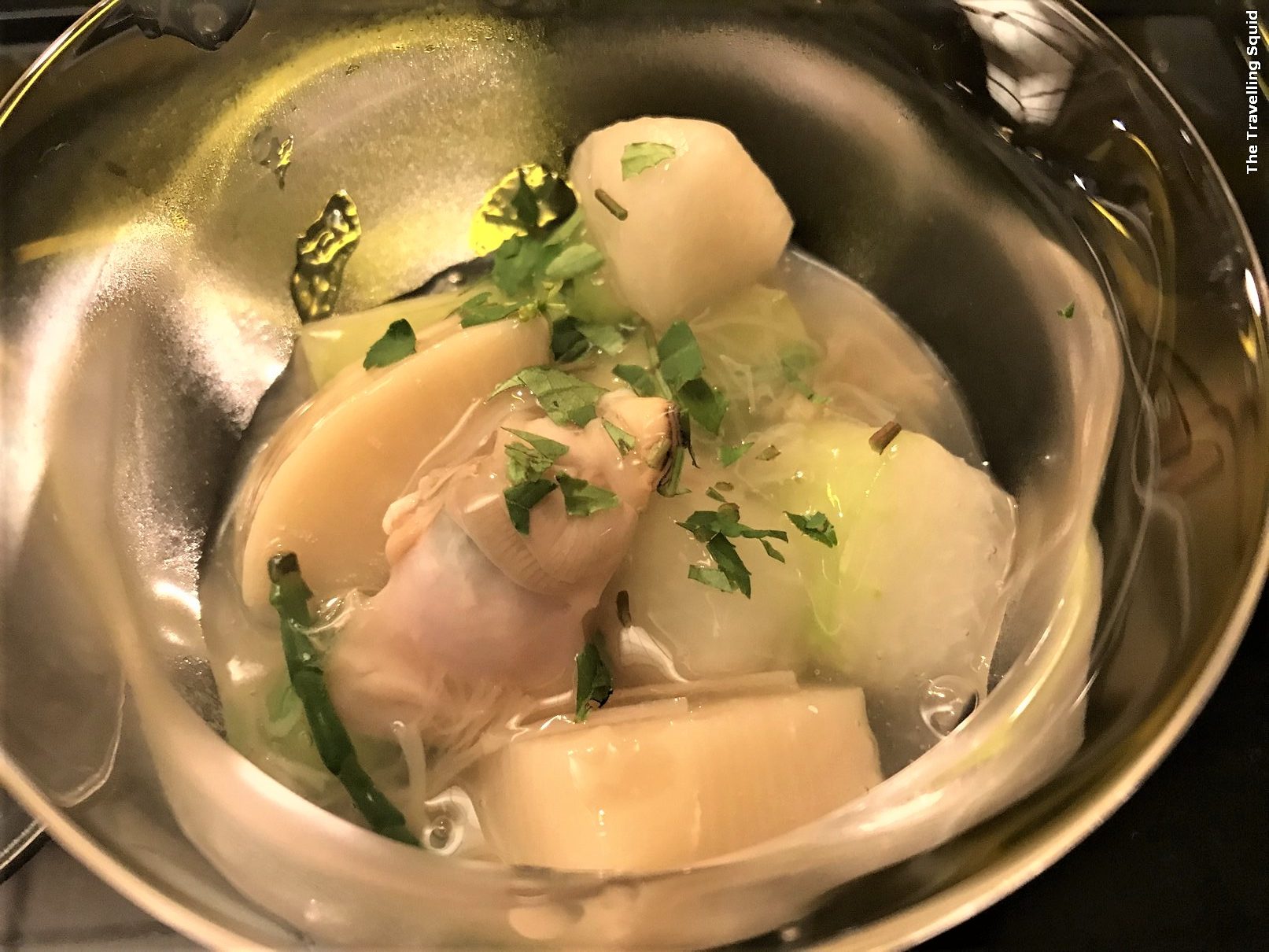
- Young bamboo, Japanese Spikenard, garlic leaves, asparagus, clam and leaf bud.
If you’re wondering what spikenard is, it’s a vegetable similar to that of asparagus. In Japanese cooking, the stems are usually boiled and served in miso soup. I love eating bamboo shoots, and the young bamboo used in this dish was fresh and mildly flavoured. It was served with clams and asparagus. Once again, a balanced and clean-tasting dish.
8. Shokuji (Rice)
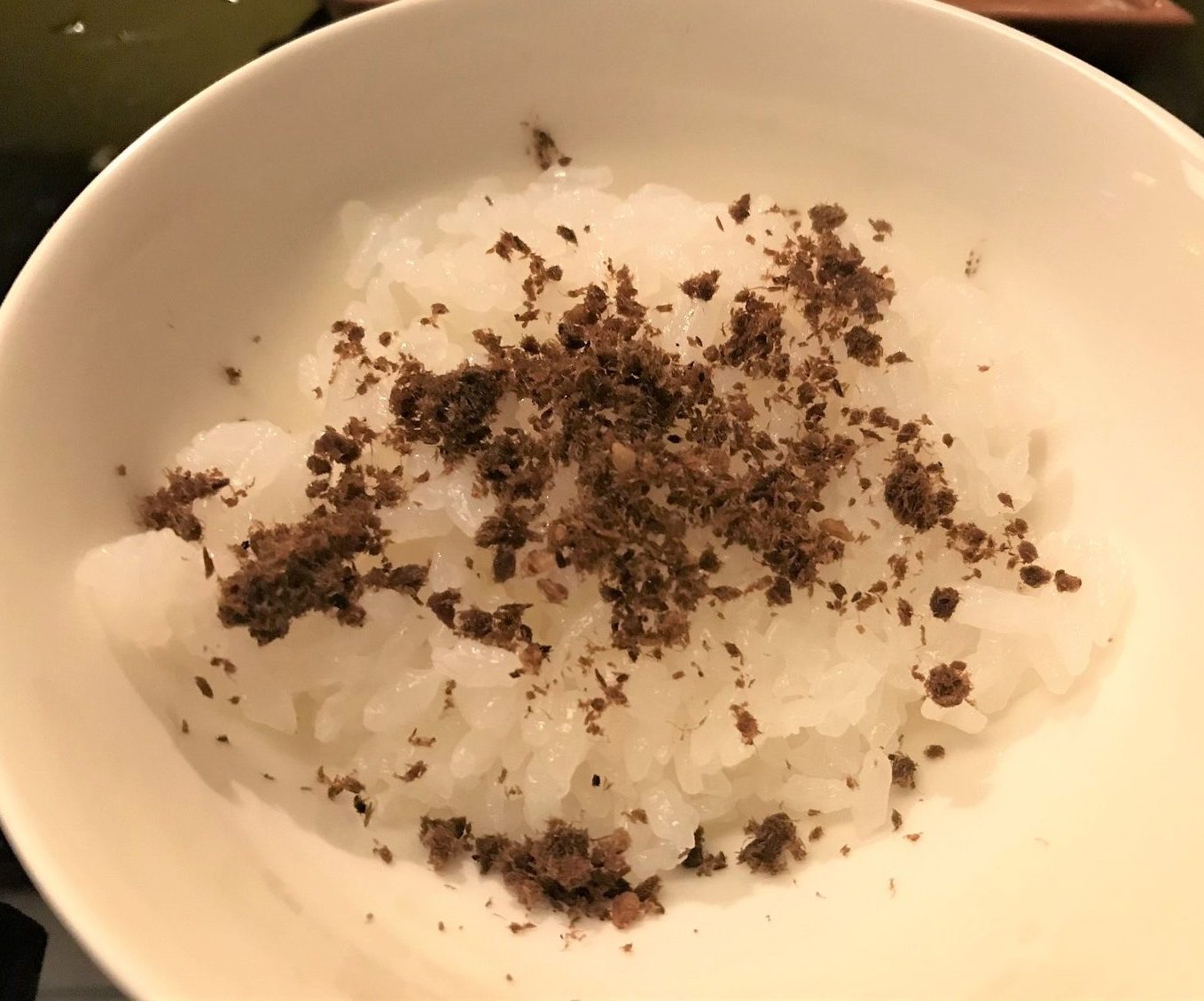
- Miso soup, pickles (radish, cucumber) and kelp with bonito flakes

This dish was special because unlike previous experiences when we had gohan (rice) with pickles, our rice came with katsuobushi instead, (a type of seasoned bonito floss, similar to pork floss we have in Singapore.) According to Wikipedia, katsuobushi is dried, fermented, and smoked skipjack tuna. It is also known as bonito flakes and young bonito is used as a cheaper substitute for skipjack tuna. Katsuobushi and dried kelp (kombu) are the basic ingredients of dashi, a type of stock which is a base for Japanese soups and sauces.
Once again, I enjoyed the texture of the rice mixed with the Katsuobushi. It was yet another simple dish done right, with the crispiness of the sakura shrimp blending into the chewiness of the rice. A perfect balance of salty and slightly sweet flavours, as you take in the fragrance from the rice.
9. Mizumono (Dessert)
For dessert, we had ice-cream, a ginger mochi (rice cake) and a matcha-soup. The matcha taste was very intense, and there was lots of umani in the bowl. It was also whisked as it is not soluble in water. Whisking also allows the tea particles to be held in suspension for a longer period of time, and affects the texture of the tea.
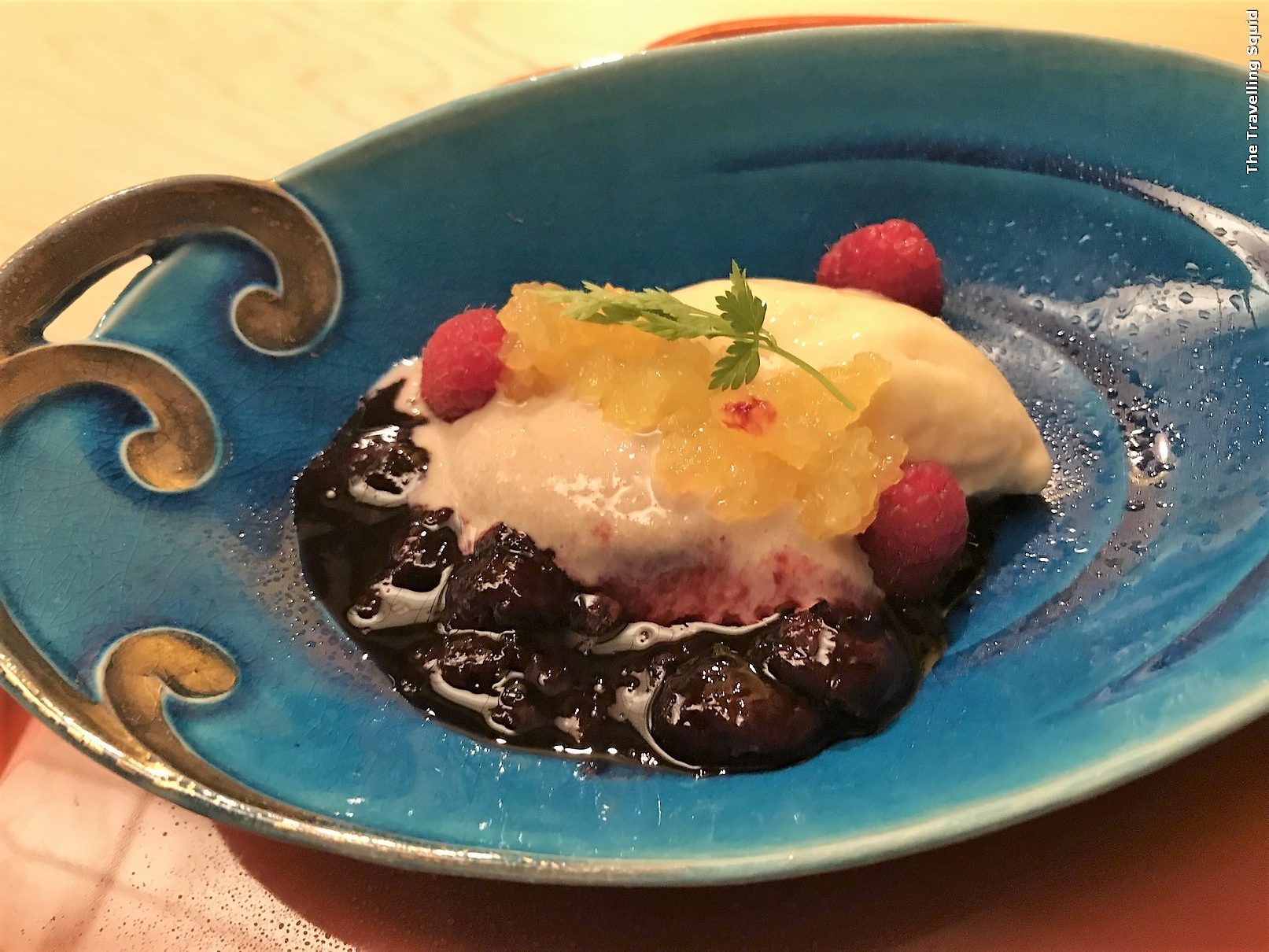
- Ice-cream (Roasted soybean flower & citrus fruit (yuzu))
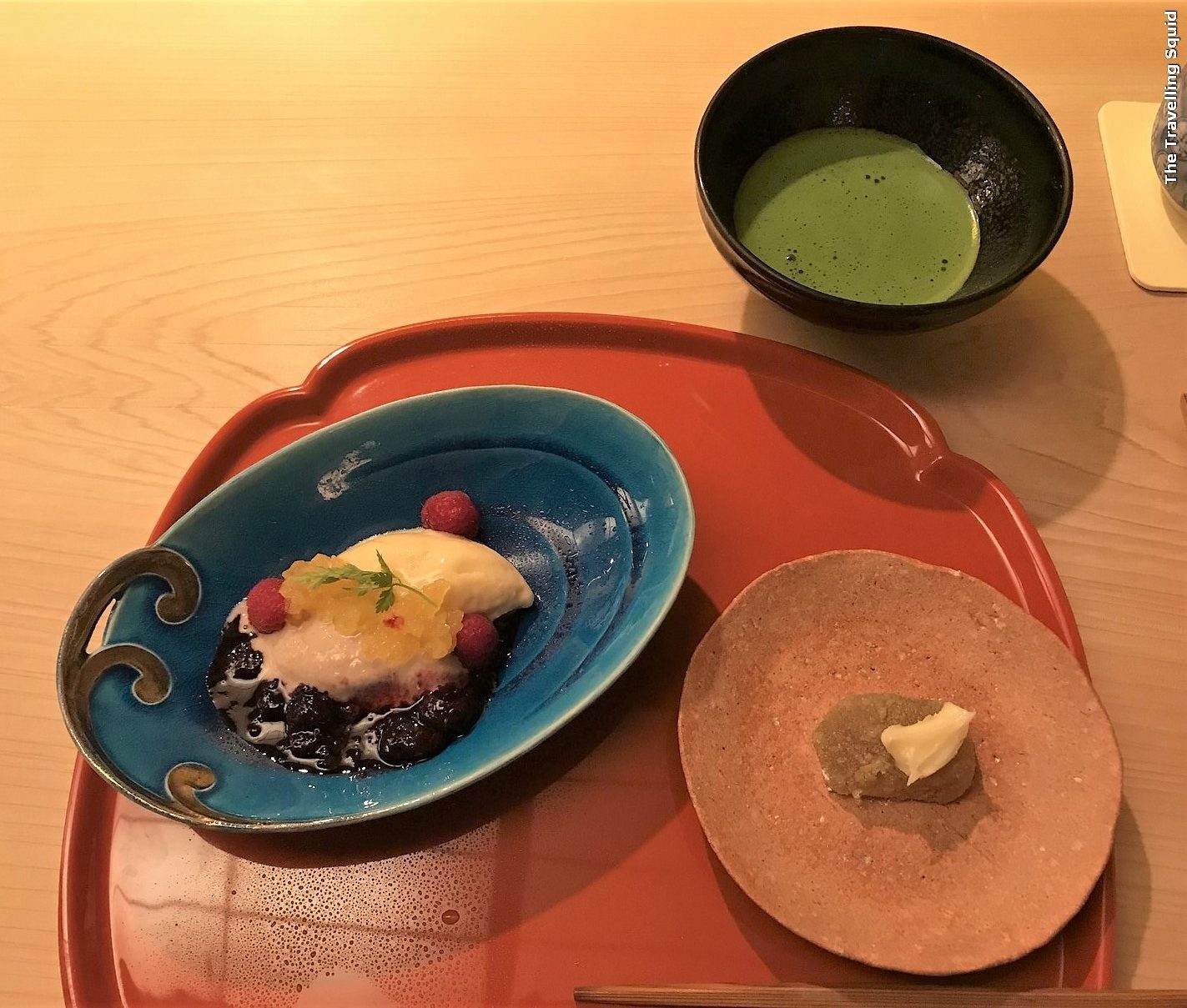
- Grape jelly, raspberry, ginger rice cake (mochi), white chocolate sauce.
The Travelling Squid’s Take
At SGD109/ USD80, our Kaiseki lunch at Gion Sutton in Kyoto was really worth it. The quality of food served done with various techniques was really well done, and in my view, aligned with the principles of a kaiseki meal – which is to do something simple and yet well-done. Unlike the kaiseki dinner we had at Lake Kawaguchiko, the ingredients used were much more simpler, but I thought the balance of flavours was better and the presentation was more in line with natural elements. It’s definitely worth a visit if you come to Kyoto! If you’re keen, do make your reservation in advance on the Mileslife app.





